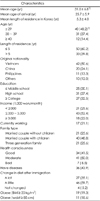Abstract
Purpose
This study was conducted to assess the nutritional status of female marriage immigrants attending Korean language class in Gwangju, Korea by analyzing daily food and nutrient intake.
Methods
Eighty-three female immigrants completed a survey. Anthropometric measurements were obtained, and dietary food intake was assessed using a 1-day 24 hour recall method.
Results
The average length of residence in Korea was 5.3 years, and mean age of subjects was 31.0 years old. The home countries of subjects were Vietnam (50.6%), China (24.1%), Philippines (13.3%), and others (12%). Due to the length of residence, there were significant differences in body weight (p < 0.05), BMI (p < 0.05), percent body fat (p < 0.05), and diastolic blood pressure (p < 0.05). The subjects who were 30~49 years old consumed more vegetables and less seaweed than the subjects who were 20~29 years old. The other kinds of consumed foods were similar among groups in different age groups or lengths of residence in Korea. Average energy intake of subjects was 1,641.0 Kcal. The group with less than 5 years of residence showed higher cholesterol intake than the group with 5 or more years of residence in Korea (p < 0.05). There was no significant difference in nutrient intake between the groups of different age or length of residence. There was a positive association among dietary cholesterol intake and consumption of eggs, milk. and dairy products, and blood pressure.
Conclusion
The study shows that length of residence affects rate of obesity and nutritional status. Further extensive research is needed to understand the effect of dietary changes and nutritional status of female marriage immigrants as well as for their successful adaptation to develop a more active and long-term nutrition education program.
Figures and Tables
Table 3
Daily Food intake according to age and the length of residence of female marriage immigrants (g)

Table 4
Daily nutrient intake according to age and the length of residence of female marriage immigrants

1) Mean ± SD, % 2) EER (estimated energy requirement) was applied to energy, EAR (estimated average requirement) was applied to protein, calcium, iron, Vit. A, thiamin, riboflavin, Vit. B6, niacin, Vit. C, folate. 3) Nutrition deficiency determined by proportion below 75% EER for energy intake and below EAR for calcium, iron, Vit. A, riboflavin 4) Significance determined by T-test between residency groups (**p < 0.01)
References
1. Statistics Korea. International marriage: 2015[Internet]. Daejeon: Statistics Korea;2016. cited 2016 Sep 30. Available from: http://www.index.go.kr/potal/main/EachDtlPageDetail.do?idx_cd=2430.
2. Kim JE, Kim JM, Seo SH. Nutrition education for female immigrants in multicultural families using a multicultural approach: indepth interviews with female immigrants and nutrition education professionals. Korean J Nutr. 2011; 44(4):312–325.

3. Tucker KL. Dietary patterns, approaches, and multicultural perspective. Appl Physiol Nutr Metab. 2010; 35(2):211–218.
4. Yang EJ, Chung HK, Kim WY, Bianchi L, Song WO. Chronic diseases and dietary changes in relation to Korean Americans’ length of residence in the United States. J Am Diet Assoc. 2007; 107(6):942–950.

5. Kim SH, Kim WY, Lyu JE, Chung HW, Hwang JY. Dietary intakes and eating behaviors of Vietnamese female immigrants to Korea through marriage and Korean spouses and correlations of their diets. Korean J Community Nutr. 2009; 14(1):22–30.
6. Jung ML, Rho SN, Kim CS. The survey of anthropometric data and dietary behavior of Chinese middle and high school students living in Incheon, Korea. J East Asian Soc Diet Life. 2007; 17(3):289–303.
7. Kim JM, Lee NH. Analysis of the dietary life of immigrant women from multicultural families in the Daegu area. J Korean Diet Assoc. 2009; 15(4):405–418.
8. Han YH, Shin WS, Kim JN. Influential factor on Korean dietary life and eating behaviour of female marriage migrants. Comp Korean Stud. 2011; 19(1):115–159.
9. Kim HR, Yeo JY, Jung JJ, Baek SH. Health status of marriage immigrant women and children from multicultural families and health policy recommendations. Seoul: Korea Institute for Health and Social Affairs;2012.
10. Asano K, Yoon J, Ryu SH. Factors related to Korean dietary adaptation in Chinese female marriage immigrants living in the Seoul metropolitan area. J East Asian Soc Diet Life. 2015; 25(2):234–245.

11. Asano K, Yoon J, Ryu SH. Chinese female marriage immigrants’ dietary life after immigration to Korea : comparison between Han-Chinese and Korean-Chinese. Korean J Community Nutr. 2014; 19(4):317–327.

12. Lee JS. The factors for Korean dietary life adaptation of female immigrants in multi-cultural families in Busan. J Korean Soc Food Sci Nutr. 2012; 41(6):807–815.

13. So J, Han SN. Diet-related behaviors, perception and food preferences of multicultural families with Vietnamese wives. Korean J Community Nutr. 2012; 17(5):589–602.

14. Kim JH, Lee MH. Dietary behavior of marriage migrant women according to their nationality in multicultural families. Korean J Community Nutr. 2016; 21(1):53–64.

15. Kim JM, Lee HS, Kim MH. Food adaptation and nutrient intake of female immigrants into Korea through marriage. Korean J Nutr. 2012; 45(2):159–169.

16. Lyu JE, Yang YJ, Lee SE, Chung HW, Kim MK, Kim WY. Nutritional status of Vietnamese female marriage immigrants to Korea in relation to length of residence in Korea. Ann Nutr Metab. 2009; 55(4):317–324.

17. Yang EJ. Dietary behaviors of female marriage immigrants residing in Gwangju, Korea. J Nutr Health. 2016; 49(3):179–188.

18. Kim JK, Kim JM, Kim H, Chung HW, Chang N. Relationship between food and nutrient intake and the risk of hypertriglyceridemia in Vietnamese women residing in Bavi: the Korean genome and epidemiology study (KoGES). Korean J Nutr. 2013; 46(1):15–25.

19. Ministry of Health and Welfare, Korea Centers for Disease Control and Prevention. Korea Health Statistics 2014: Korea National Health and Nutrition Examination Survey (KNHANES VI-2). Sejong: Korea Centers for Disease Control and Prevention;2015.
20. Hwang JY, Lee H, Ko A, Han CJ, Chung HW, Chang N. Dietary changes in Vietnamese marriage immigrant women: the KoGES follow-up study. Nutr Res Pract. 2014; 8(3):319–326.

21. Mohan V. Why are Indians more prone to diabetes? J Assoc Physicians India. 2004; 52(6):468–474.




 PDF
PDF ePub
ePub Citation
Citation Print
Print






 XML Download
XML Download